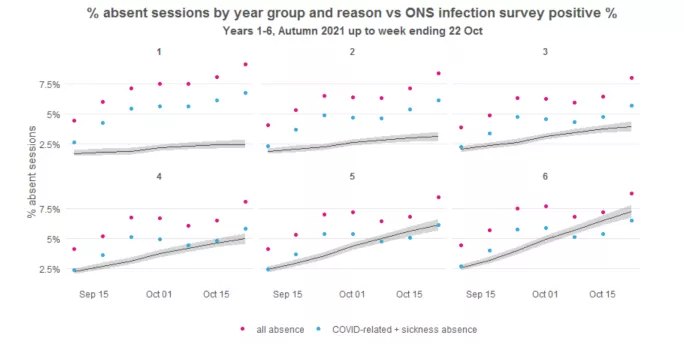Tens of thousands of pupils may have been attending school with asymptomatic Covid after infection rates in some primary year groups ran higher than absences, an analysis by experts has revealed.
FFT Education Datalab has compared infection estimates by week and year group produced by the Office for National Statistics (ONS) with its own school absence data at the same time this term.
The analysis shows that pupils in Years 5 and 6 had sickness and Covid absence rates lower than the infection rate in recent weeks.
More:
Covid: Teacher and pupil absence ‘wreaking havoc’, say leaders
Trial: Can air purifiers halt spread of Covid in schools
DfE: Majority of school CO2 monitors not yet delivered
Datalab’s Katie Beynon told Tes the analysis suggests between 38,000 and 49,000 Years 5 and 6 pupils could have been in school with asymptomatic Covid infection in the week ending 15 October, while between 31,000 and 45,000 may have been in classrooms in the last week of half term, ending on 22 of last month.
In a new blog, FFT Education Datalab Ms Beynon said this trend was also seen among younger secondary school year groups.
She adds: “We think it means that lots of these pupils were attending school with asymptomatic Covid.”
She adds: “One thing that is as expected is we do see that both absence and infection rates increased as term went on. With absence between eight and nine per cent in the final week of half term, any further rise in infections would likely cause serious disruption.”
The analysis also shows that pupils in Year 1 consistently had the highest rate of absence due to sickness or Covid, but the lowest infection rate.
The blog writes: “This suggests that non-Covid sickness was much more prevalent in Year 1 than in any other year group.”
The research used 4,600 primary schools subscribed to the FFT Datalab’s Aspire Attendance Tracker which provides input from around 25 per cent of state funded primaries in England.
The data also compared absence with the relevant ONS Covid infection estimates for different age groups.
How does absence compare with the past two years?
The blog post also compares attendance this half term with the same point in the previous two academic years.
It finds that absence has improved slightly compared with the first half term last year, but has still been a lot higher than pre-pandemic levels.
Overall, absence was 6.5 per cent this year compared with 7.1 per cent last year and 4.2 per cent in 2019.
Year 1 was the only year group where absence wasn’t lower than last year. But, like all other year groups, it was higher than pre-pandemic levels.
The most recent Department for Education statistics shows that Covid-related absence among state school pupils was 3.2 per cent on 21 October, up from 2.6 per cent the week before.





